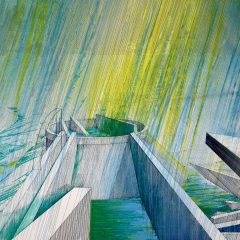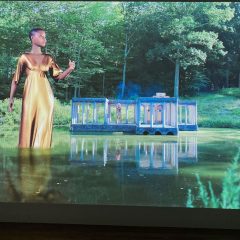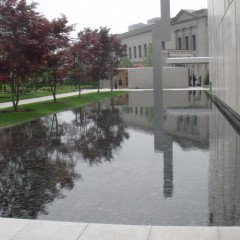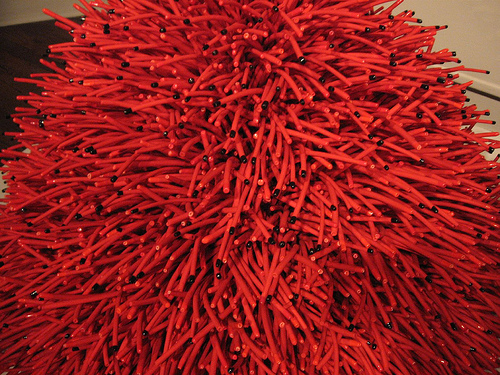
Red Cone, detail, by Bean Finneran
The wonderful glass and ceramics exhibit at the Philadelphia Art Alliance made me think instantly of the discussion evinced by Roberta’s post on American Craft magazine changing its name. The Art Alliance exhibit is all about fine craft, and process and materials. It measures as art for a number of reasons, the first of which is the excellence of its craftsmanship. This work is also something more; its handling and its inventiveness are both wonderful to look at, and even more important–wonderful to consider seriously for content.
Bean Finneran’s exhibit, Realms, includes composite pieces made of slender curves of ceramic material that look sort of like straws, except they are solid. Each sculpture is assembled anew from the tiny component pieces for each installation. The saturated colors, the fragility of the material, the suggestion of flexibility where there is none, the mop-head references all made me want to touch and recoil from touching all at once.
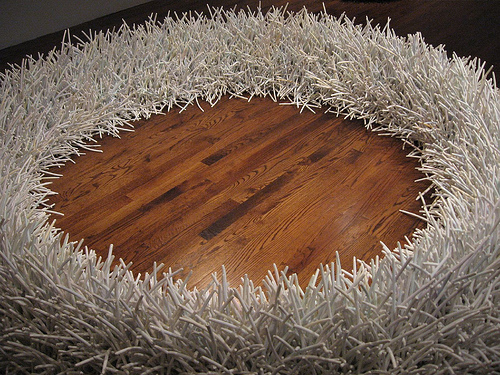
White and Pastel Ring, detail
White and Pastel Ring has nearly 13,000 ceramic sticks assembled for this installation. The labor alone is stunning, but it’s also good to look at. I preferred the smaller pieces however–but I put that choice down to taste, not to a serious lack of quality. The work is really great.
I suppose my favorite was the saturated Red Cone, with its look of a red mop and a sea urchin. I also loved the Black Cone with silver tips, which reminded me of a porcupine–but less regular in the arrangement of the spines.
The methodology of arranging the spines puts me in mind of the late Brian Wagner’s 5000 Sticks, which required some physics to explain its stability as a piece. But because of the delicacy of Finneran’s parts, their shape and their number, I am also reminded of Astrid Bowlby’s cumulative mark-making.
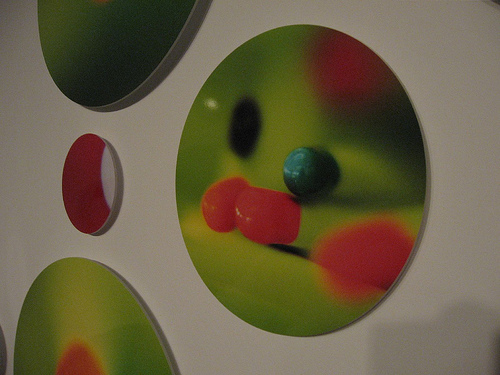
Lattice, detail, by Bean Finneran; the colors look like they are straight out of the fashion pages, but the source for these images is natural
Lattice, an exuberant array of circular plates on the walls, with a ’50s palette of bouncy lozenges and pill-shapes floating on acid-green circles, has a highly technical description having to do with growing zinc crystals. The piece is actually C-prints mounted on plexiglass, but the product has a visual life that transcends both its material and its source and reminds me a bit of Stephan Barris’ lozenges of light and color floating on plexiglas behind some kind of wax. But whereas Barris’ touch is subtle and contemplative and about real space as we know it, Finneran’s touch shouts for attention as it calls us to note what I take to be tiny, atomic-scale space. The arrangement on the wall, however, moves the piece into interplanetary cosmology.
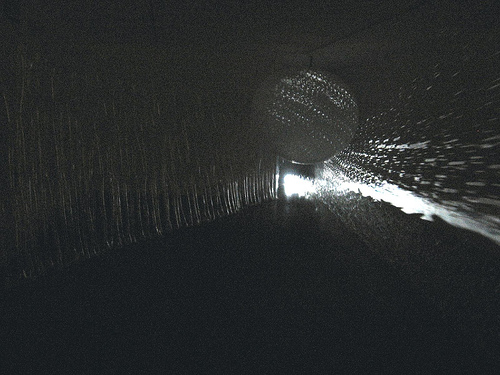
Gravity, by Jon Clark and Angus Powers, with sound by Jesse Daniels, a glass and multimedia installation.
And intimations of the interplanetary cosmos are the subject of Gravity, by Jon Clark and Angus Powers, a full-room glass and multimedia installation with sound by Jesse Daniels.
Clark is the head of the glass department at Tyler, and Powers, a Tyler MFA, is teaching right now at Alfred University’s School of Art and Design. Their installation is a visual whiz-bang that can’t be caught by me and my camera (perhaps in more talented hands, it would be possible; I consider this image an utter failure). The piece sparkles and whirls in a sort of cosmic wind tunnel, while giving off the noise of interstellar storms–or at least all these things as we imagine they might be. It’s the Make Believe Ballroom mirrorball exploding into a planet.
Part of what makes the piece wonderful is that you cannot enter the space, and although that emphasizes the cinematic lights swirling around, it also emphasizes how forbidding and inaccessible real outer space is. A palisade of glass sticks are piled up on one side of the room, looking quite mysterious as they catch and reflect bits of light. This is a version of a piece that already showed at Delaware Center for Contemporary Art and at Wilkes University.
Just like the photo doesn’t capture the piece, neither do my words. You have to be there and see it for yourself.


